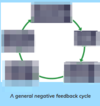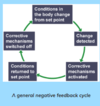NERVOUS SYSTEM IN HUMANS Flashcards
(62 cards)
The Nervous System
The human nervous system consists of the:
central nervous system (CNS) – the brain and the spinal cord
peripheral nervous system (PNS) – all of the nerves in the body
It allows us to make sense of our surroundings and respond to them and to coordinate and regulate body functions
Information is sent through the nervous system as nerve impulses – electrical signals that pass along nerve cells known as neurones
A bundle of neurones is known as a nerve

Types of Neurone
There are three main types of neurone: sensory, relay and motor
Sensory neurones carry impulses from sense organs to the CNS (brain or spinal cord)
Relay neurones are found inside the CNS and connect sensory and motor neurones
Motor neurones carry impulses from the CNS to effectors (muscles or glands)
Neurones have a long fibre (axon)
This means that less time is wasted transferring the impulse from one cell to another
The axon is insulated by a fatty sheath with small uninsulated sections along it (called nodes)
This means that the electrical impulse does not travel down the whole axon, but jumps from one node to the next
Their cell body contains many extensions called dendrites
This means they can connect to many other neurones and receive impulses from them, forming a network for easy communication
draw a diagram of a typical neurone

Identifying the types of neurone:
Sensory neurones are long and have a cell body branching off the middle of the axon
Relay neurones are short and have a small cell body at one end with many dendrites branching off it
Motor neurones are long and have a large cell body at one end with long dendrites branching off it

draw three types of neurone

Voluntary & Involuntary Responses
A voluntary response is one where you make a conscious decision to carry out a particular action therefore it starts with your brain
An involuntary (or reflex) response does not involve the brain as the coordinator of the reaction and you are not aware you have completed it until after you have carried it out
Involuntary actions are usually ones which are essential to basic survival and are rapid, whereas voluntary responses often take longer as we consider what the response might be before doing it
The Reflex Arc
An involuntary (or reflex) response does not involve the brain as the coordinator of the reaction and you are not aware you have completed it until after you have carried it out
This is an automatic and rapid response to a stimulus such as touching something sharp or hot
As it does not involve the brain, a reflex response is quicker than any other type of nervous response
This helps to minimise the damage to the body
Reflex actions are:
Automatic
Fast
Protective
Reflex actions
Heat (the stimulus) is detected by a temperature receptor in the skin
Sensory neurone sends electrical impulses to the spinal cord (the coordinator)
Electrical impulse is passed on to relay neurone in the spinal cord
Relay neurone connects to motor neurone and passes the impulse on
Motor neurone carries impulse to the biceps muscle in the arm (the effector)
Biceps muscle will contract and pull the arm up and away from the hot object (the response)
The reflex pathway

The Synapse: Definition
The junction between two neurones is known as a synapse
How an Impulse is Passed Across a Synapse
Neurones never touch each other
The junctions (gaps) in between them are called synapses
The electrical impulse travels along the first axon
This triggers the nerve-ending of the presynaptic neurone to release chemical messengers called neurotransmitters from vesicles which fuse with the presynaptic membrane
The neurotransmitters diffuse across the synaptic gap and bind with receptor molecules on the membrane of the second neurone (known as the post synaptic membrane)
This stimulates the second neurone to generate an electrical impulse that travels down the second axon
The neurotransmitters are then destroyed to prevent continued stimulation of the second neurone which would cause repeated impulses to be sent
Synapses ensure that impulses only travel in one direction, avoiding confusion within the nervous system if impulses were travelling in both directions
As this is the only part of the nervous system where messages are chemical as opposed to electrical, it is the only place where drugs can act to affect the nervous system – eg this is where heroin works

synapse : for maximum marks you will need to be able to understand
the structure and functioning of a synapse and explain what happens at each step.
receptors
Receptors are groups of specialised cells
They detect a change in the environment and stimulate electrical impulses in response
Sense organs contain groups of receptors that respond to specific stimuli
Once the receptor cell in the sense organ has been stimulated, it generates an electrical impulse
This is passed on to a sensory neurone which carries the impulse to the central nervous system
Here a response will be decided on and the impulse will be passed to a motor neurone (via a relay neurone)
The motor neurone carries the impulse to the effector (muscle or gland)
The effector carries out the response
sense organs
Sense organs contain groups of receptors that respond to specific stimuli

Structure of the Eye


what’s the eye ?
The eye is a sense organ containing receptor cells that are sensitive to light (rod cells) and colour (cone cells)
functions of structures in the eye

what is a Pupil Reflex?
This is a reflex action carried out to protect the retina from damage in bright light and protect us from not seeing objects in dim light
In dim light the pupil dilates (widens) in order to allow as much light into the eye as possible
In bright light the pupil constricts (narrows) in order to prevent too much light entering the eye and damaging the retina

How does the Pupil Reflex Work?
dim light

How does the Pupil Reflex Work?
bright light






































